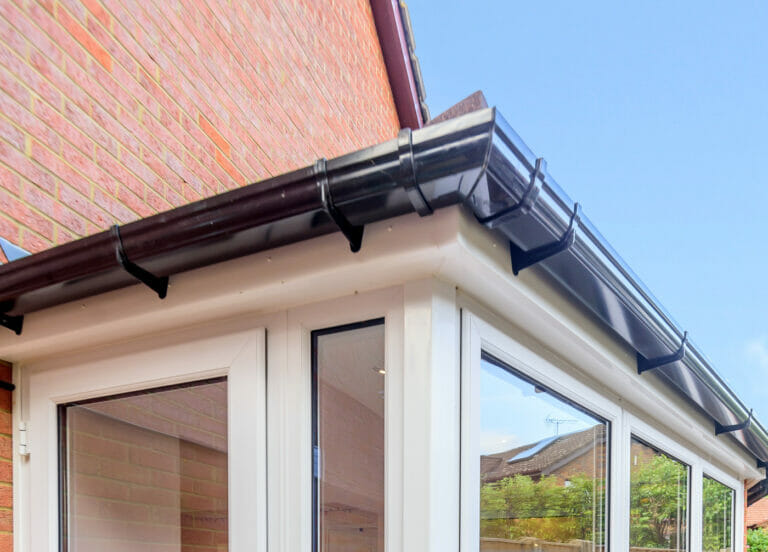Quick FAQs
[rank_math_rich_snippet id=”s-84cba733-4d5d-42b9-8ca1-48d7ee739596″]
Guttering is an essential part of any building, as it directs rainwater away from the roof and the walls, preventing damage and erosion. The gutters collect the water, and the downspouts allow the water to drain away effectively.
Guttering and downspouts can become a liability if not maintained and cleaned properly. Over time, twigs, leaves, and other debris can build up in the guttering, clogging the downspouts and causing water to overflow onto the roof, the walls, or the foundation. This can lead to leaks, mould growth, and even structural damage.
Read on for our top tips on guttering and downspout maintenance.
Inspect Your Guttering Regularly
The best way to prevent guttering problems is to catch them early. That’s why it’s a good idea to inspect your guttering at least twice a year, in the spring and in the autumn, when leaves and debris are most likely to accumulate.
Look for signs of damage, such as rust, corrosion, cracks, or loose fasteners. Also, check if the guttering is properly sloped towards the downspouts and if there are any sagging or misaligned sections. If you notice any issues, address them promptly, before they become worse.
How to Clear Debris from Guttering
The most common guttering problem is clogging. Leaves, twigs, and other debris can accumulate in the guttering and block the flow of water, causing it to overflow or back up. This can lead to water damage and mould growth, as well as attract pests such as mosquitoes, rodents, and birds.
To prevent clogging, use a ladder, gloves, and a scoop to remove the debris from the guttering. You can also use a leaf blower or a pressure washer to flush out the guttering, but be careful not to damage the guttering or the roof.
How to Clean Your Downspouts
The downspouts are the vertical pipes that carry the water from the guttering to the ground. They can also become clogged with debris, especially at the elbow joints or the bottom.
To clean the downspouts, use a plumber’s snake or a high-pressure hose to push or flush out the debris. You can also remove the bottom cap and scoop out the debris by hand. Make sure the downspouts are properly connected and directed away from the foundation, to prevent water from pooling or infiltrating.
When and How to Repair and Replace Your Guttering
If you notice any damage or wear and tear in your guttering, don’t hesitate to repair or replace it. Small cracks or leaks can be sealed with silicone caulk or roofing cement, while larger holes or rusted sections may require patching or replacement.
Similarly, if your guttering is old or ineffective, consider upgrading to a newer and more durable system. Modern guttering comes in a variety of materials, such as aluminium, copper, steel, or vinyl, and can be customized to fit your specific needs and preferences.
The Benefits of Gutter Guards
Installing gutter guards is a great way to protect your gutters from debris and extend their lifespan. There are many different types of gutter guards available, so you can choose one that fits your needs and budget.
Benefits include:
- Reducing the need for gutter cleaning. Gutter guards prevent leaves, twigs, and other debris from clogging your gutters, which means you’ll have to clean them less often. This can save you time and money.
- Extending the lifespan of your gutters. Clogged gutters can cause water damage to your gutters and fascia boards. Gutter guards help to prevent this damage by keeping your gutters clean and free of debris.
- Improving drainage. Gutter guards help to ensure that water flows freely through your gutters and downspouts. This can help to prevent water damage to your foundation and landscaping.
- Preventing pests. Gutter guards can help to prevent pests, such as mosquitoes and rodents, from nesting in your gutters.
The Importance of Cleaning and Maintaining Your Guttering
In conclusion, maintaining and cleaning guttering is an important task for any homeowner or property owner. By scheduling regular inspections, clearing the debris, cleaning the downspouts, and repairing or replacing as needed, you can ensure that your guttering functions properly and protects your building from water damage and other hazards.
If you are not comfortable or skilled in doing this yourself, consider hiring a professional guttering contractor to help you. Either way, don’t neglect your guttering, as it can save you a lot of trouble and expense in the long run.
Need help with maintaining your gutters and downspouts?
If you’d like to talk to one of our experts about effective ways to look after your home’s guttering, feel free to reach out and we’ll gladly help.

